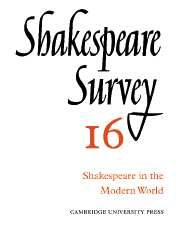Book contents
- Frontmatter
- An Obligation to Shakespeare and the Public
- Our Closeness to Shakespeare
- The Popularity of Shakespeare: An Examination of the Royal Shakespeare Theatre’s Repertory
- Shakespeare and the Fashion of These Times
- An Approach to Shakespearian Tragedy: The ‘Actor’ Image in Macbeth
- Shakespeare’s Impact Today in France
- Shakespeare and the Modern World
- Modern ‘Theatrical’ Translations of Shakespeare
- Shakespeare as ‘Corrupter of Words’
- Shakespeare in Ghana
- ‘Timon of Athens’
- Who Strutted and Bellowed?
- Shakespeare in Planché’s Extravaganzas
- ‘Our Will Shakespeare’ and Lope de Vega: An Unrecorded Contemporary Document
- Shakespeare and the Mask
- International Notes
- Shakespeare Productions in the United Kingdom: 1961
- Acting Shakespeare Today. A review of performances at the Royal Shakespeare Theatre, August 1962
- Canada’s Achievement
- 1 Critical Studies
- 2 Shakespeare’s Life, Times and Stage
- 3 Textual Studies
- Books Received
- Index
- Plate section
The Popularity of Shakespeare: An Examination of the Royal Shakespeare Theatre’s Repertory
Published online by Cambridge University Press: 28 March 2007
- Frontmatter
- An Obligation to Shakespeare and the Public
- Our Closeness to Shakespeare
- The Popularity of Shakespeare: An Examination of the Royal Shakespeare Theatre’s Repertory
- Shakespeare and the Fashion of These Times
- An Approach to Shakespearian Tragedy: The ‘Actor’ Image in Macbeth
- Shakespeare’s Impact Today in France
- Shakespeare and the Modern World
- Modern ‘Theatrical’ Translations of Shakespeare
- Shakespeare as ‘Corrupter of Words’
- Shakespeare in Ghana
- ‘Timon of Athens’
- Who Strutted and Bellowed?
- Shakespeare in Planché’s Extravaganzas
- ‘Our Will Shakespeare’ and Lope de Vega: An Unrecorded Contemporary Document
- Shakespeare and the Mask
- International Notes
- Shakespeare Productions in the United Kingdom: 1961
- Acting Shakespeare Today. A review of performances at the Royal Shakespeare Theatre, August 1962
- Canada’s Achievement
- 1 Critical Studies
- 2 Shakespeare’s Life, Times and Stage
- 3 Textual Studies
- Books Received
- Index
- Plate section
Summary
Shakespeare’s dominance of the English stage between 1945 and 1960 has been so marked that one of the more distinguished contemporary playwrights has recently bracketed his works and pantomimes as the two menaces of the modern English theatre. Every year since 1946 at least fifty professional and amateur productions of the plays are presented in the United Kingdom. In Europe during the same period the level of interest has been equally high. Germany not only managed to keep Shakespeare in the theatre repertories during the war, but within four years of its termination could register thirty-three new productions in a single year, including plays like Timon of Athens and The Two Gentlemen of Verona. Even in 1958, the Schiller bi-centenary year, Shakespeare remained the most popular dramatist on the German stage, with his plays receiving six hundred performances more than those of the German dramatist, in spite of the numerous Schiller Festivals. As early as 1947, Poland was able to stage an astonishing ten-play Shakespeare Festival in Warsaw and, since then, it has witnessed thousands of performances of his works. In the post-war Russian theatre the Shakespeare activity has been prodigious with many productions in Moscow and Leningrad, most of the individual Republics mounting the popular plays at their ‘national’ theatres, and producers more and more keen to stage works, such as Cymbeline, A Winter’s Tale and Richard II, which were previously less well known in these countries.
- Type
- Chapter
- Information
- Shakespeare Survey , pp. 18 - 29Publisher: Cambridge University PressPrint publication year: 1963

